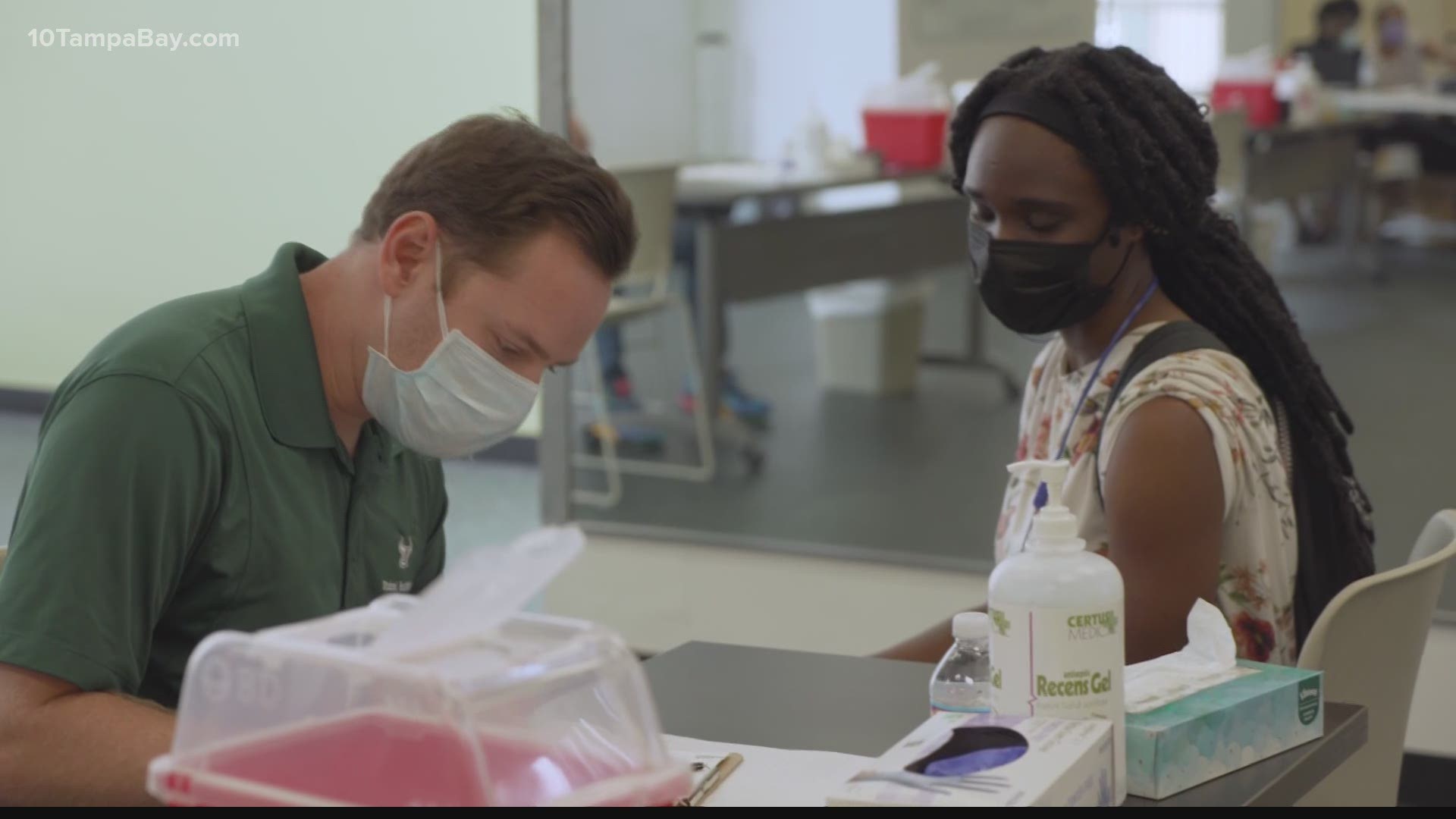TAMPA, Fla — 200-MILLION GOAL REACHED:
200 million vaccines in arms. On Thursday, nine days before the 100th day goal given by President Joe Biden, that goal has been reached.
Some local healthcare professionals say this is an emotional milestone.
"It's just astounding. To be honest, to be a public health professional at this time, to see this, it's so incredibly heartening," Dr. Jill Roberts with USF Health to 10 Investigates' Jennifer Titus.
And, we're not at day 100 yet.
10 Investigates has been tracking the doses and updating you on the progress every 10 days.
We'll have another update for you when we hit day 100.
DAY 90 UPDATE:
We are 10 days away from reaching the 100-day promise that President Joe Biden made to get 200 million vaccines in arms. Today's numbers show we are at 198.4 million shots in arms under the Biden administration, a little more than 1.5 million away from that goal.
In Florida, more than 5 million people are fully vaccinated.
A majority of those people are over 65.
Experts say the younger population still has a long way to go before that age group is fully vaccinated.
"We're doing a very comprehensive approach to this," said Joseph Puccio, the Executive Director of Student Health Services at the University of South Florida. "We're really trying to educate the students that if we want to get the university community environment as close to normal as possible, we need as many people to be vaccinated."
Puccio says not only are they working to educate students about the vaccine, but they are also giving those shots right on campus.
The university sent a survey to students asking them whether or not they'd be interested in a vaccine and many responded.
"We had almost 1,500 students respond within a day or two of the survey going out. And most, the vast majority were interested in trying to get scheduled for a vaccine," Puccio explained.
But he says there is still some hesitancy among young people.
"I think the younger people really have not had the very serious side effects to the infection," Puccio said. "So, I think, they don't see the causal relation of what the vaccine could prevent. There's not going to be as much interest in getting it. So, what we are trying to do is really educate the students and the community at USF that getting the vaccine really helps the entire community in addition to themselves."
A study just released by a professor at Florida Atlantic University found Florida had one of the highest rates of infection for younger residents in 2020.
"Being vaccinated not only protects you, it protects your family and it does protect the whole USF community," Puccio said.
So far, the state of Florida has fully vaccinated 5 million residents.
Two percent are under 25 years old.
That's why many universities are doing the same thing USF is doing and holding vaccination clinics on campus.
"The more people that we vaccinate on the USF community, the more likelihood that we can have a safe return to campus in the fall and resume many of our traditional interactions on the university campus," Puccio said.
And some universities across the country are not only encouraging students to be vaccinated but demanding it. That includes Duke, Rutgers and Nova Southeastern University here in Florida.
DAY 80 UPDATE:
We are 80 days into President Joe Biden's 100-day promise to get 200-million shots into American arms.
As of Day 80, 169.5 million shots have gone into arms with 20 days left.
Since last week, all residents in Florida are eligible for a COVID vaccination and Biden is now requiring all states to follow the same path making all U.S. adults eligible for the vaccine by April 19.
While the rollout continues moving along here in the states, that's not necessarily the case around the world.
Just like the rest of us, this past year has been different for Karolina Mackiewicz.
"Well, I think that, to some extent, has been exactly the same, like everywhere else, of course, with all the limitations with everything that was changed because of the pandemic," Mackiewicz said.
While there are similarities, Mackiewicz's experience with the pandemic takes us far away from the Tampa Bay area, 5,000 miles away to her home in Helsinki, Finland.
"So this spring arrived. But in Finland, this means around five degrees and it was snowing this morning," Mackiewicz said.
The weather isn't the only difference, from Finland to the U.S., vaccine rollout has been different, too.
In Finland, people are also rushing to get a vaccine. But unlike Florida, and most of the U.S., Mackiewicz can't get a shot yet.
"I think that is impressive, she said. "And of course, we are very envious when we look at the numbers of the people vaccinated in U.S. or in U.K. or in Israel."
Envious of the United States.
According to Oxford researchers at "Our World in Data," the U.S. ranks 4th overall worldwide when It comes to the number of people who have received 1 vaccination.
Israel is No. 1, followed in second by the United Kingdom.
So far, 119,242,902 people in the U.S. have gotten 1 vaccine since the beginning of the rollout. Since Biden took office, 169.5 million shots have gone into arms.
That's 85% of his goal to reach 200-million shots in arms in his first 100 days. In Florida, 4.5 million people have been fully vaccinated. That is 21% of the population.

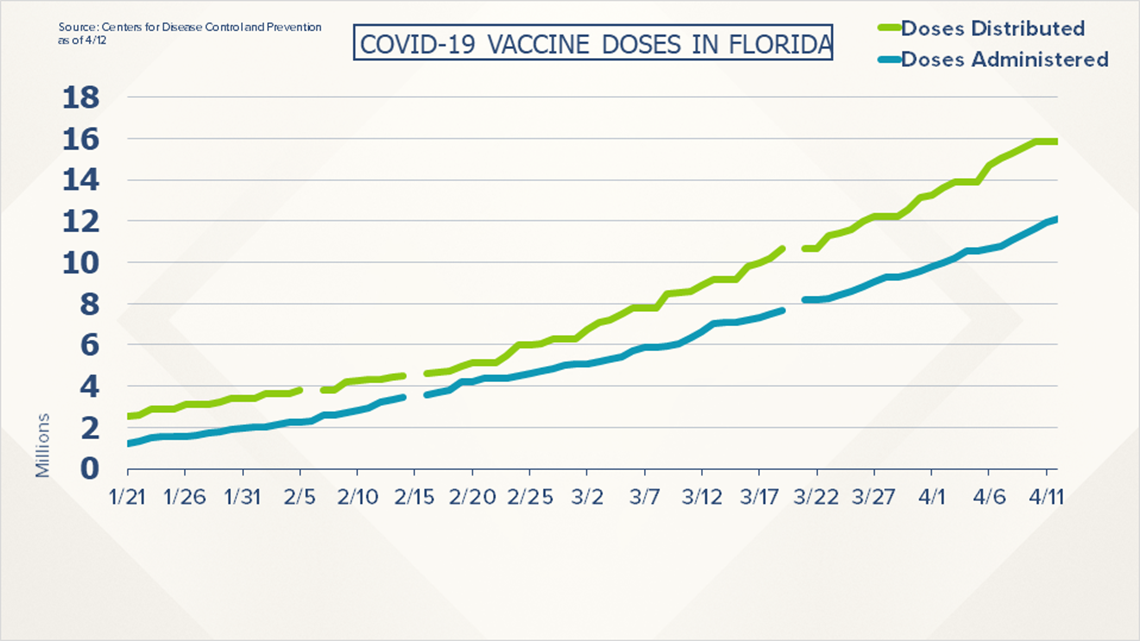
Back in Finland, Mackiewicz says right now anyone 65 years old and older can get a vaccination, so the 38-year-old still has a little time before it's her turn.
"We will be able to make an appointment only in June for the for the first dose June or July. So, we're waiting in a queue," Mackiewicz said.
But, Mackiewicz says the payoff after getting that first shot, is worth the wait.
And, despite the differences, Finland used a similar method for their rollout that Florida did, starting with older citizens and health care workers.
DAY 70 UPDATE:
We are 70 days into President Biden's 100 day promise to get vaccines out to Americans.
In just 3 days, anyone 16 and older who wants a shot in Florida, is eligible to get one.
But being eligible and finding a vaccine are two different stories.
10 investigates has learned that Florida's biggest shipment of vaccines is heading this way next week.
And now there's even more places administering shots.
Phyllis Rader has been waiting a long time for her pharmacy to get doses of COVID-19 vaccines.
She is a Pharmacist at Main Street Pharmacy in Safety Harbor.
She says they are excited to finally be able to vaccinate their customers with the COVID 19 Vaccine.
Titus: "What's been the response ever since they finally said yes, here you go? Have you guys seen the need?"
Phyllis: "Oh my gosh, it's overwhelming. I mean, we had a lot of our customers coming in and asking us if we were going to get it we kept saying yes, we're on the list, but we don't know when. And ever since we got it, our phone has not stopped ringing. I had to hire some extra help."
She says she's perfectly fine with that if it means they are helping to get shots in arms.
Phyllis: "We're getting as many as we can we've done over 500 by now in the last like three weeks. But there's still a great need. There's a really great need and they're gonna opening it up again."
On Monday, eligibility opens for those 18 and up for those wanting Moderna or Johnson and Johnson. Those 16 and up can get the Pfizer vaccine.
This comes on top of the President's latest goal of 200 million shots in 100 days.
So far, the country has administered 136.1 million shots since he made that promise.
That's 68% of his goal with 30 days left to get there.
Florida has given 8.5 million shots.
16.9% of the state's residents have been fully vaccinated at this point.
Phyllis: "It's more personable here. And people really like that it's a little bit more homey here. And people do like coming in here and getting this shot."
Now with more options to find a vaccine, like Main Street Pharmacy, Phyllis hopes when eligibility expands Monday those wanting an appointment will be able to find one.
Phyllis: "We do try to give them a little bit more attention than you might get somewhere else."
We've also learned that Florida will be getting its largest supply of vaccines yet. More than 800,000 first doses are headed to the Sunshine State which should hopefully help open more appointments.
DAY 60 UPDATE:
The goal has been hit.
Under President Joe Biden's administration, more than 100 million COVID shots have gone into people's arms in his first 60 days in office.
But even so, there are still millions of people who haven't gotten their first shot.
So far, nationwide, 13.3 percent of the population has been fully vaccinated.
The president says he is considering doubling the original goal from 100 million to 200 million and has also said by May 1, there will be an available dose for every American.
Although the supply has increased nationwide, one group of pharmacists says they are still waiting for their vaccination supply. If the doctor prescribes it, there's a good chance Alexander Pharmacy has it.
"Well we have the freezer and everything ready," Trish Huynh, a pharmacist at Alexander Pharmacy said as she gave a virtual tour of the pharmacy.
But the vaccine supply isn't inside that freezer.
"Are you guys looking forward to the day when you guys can help administer the COVID vaccine?" 10 Investigates' Jennifer Titus asked.
"Yes, definitely," Huynh said. "We did all the training, we bought all the equipment and we're just waiting, waiting and waiting."
Big chain pharmacies like CVS and Walgreens have been getting their vaccines for months now, but these small, local pharmacies still haven't gotten theirs.
"And you know, independent pharmacies make up more than 20,000 stores nationwide," Huynh explained.
And Florida is in the Top 5 states in the country with the most independent pharmacies.
"I think that a lot of independent pharmacies are in the same boat as me, like waiting. I know the CVS and Walgreens and Publix that seem to have gotten first initial shipments, it makes sense. They're bigger, they have much more walk-in traffic, that kind of thing. But yeah, I think independent pharmacies, we are kind of waiting on what to do," said Nick DeMatteo at Bailey Pharmacy.
"I mean, we're ready for it. And yeah, I mean, the day we get it, is the day I'll be doing my first shot."
So far Florida has administered 8.2 million vaccines. That means 12.6 percent of Florida residents have been fully vaccinated.

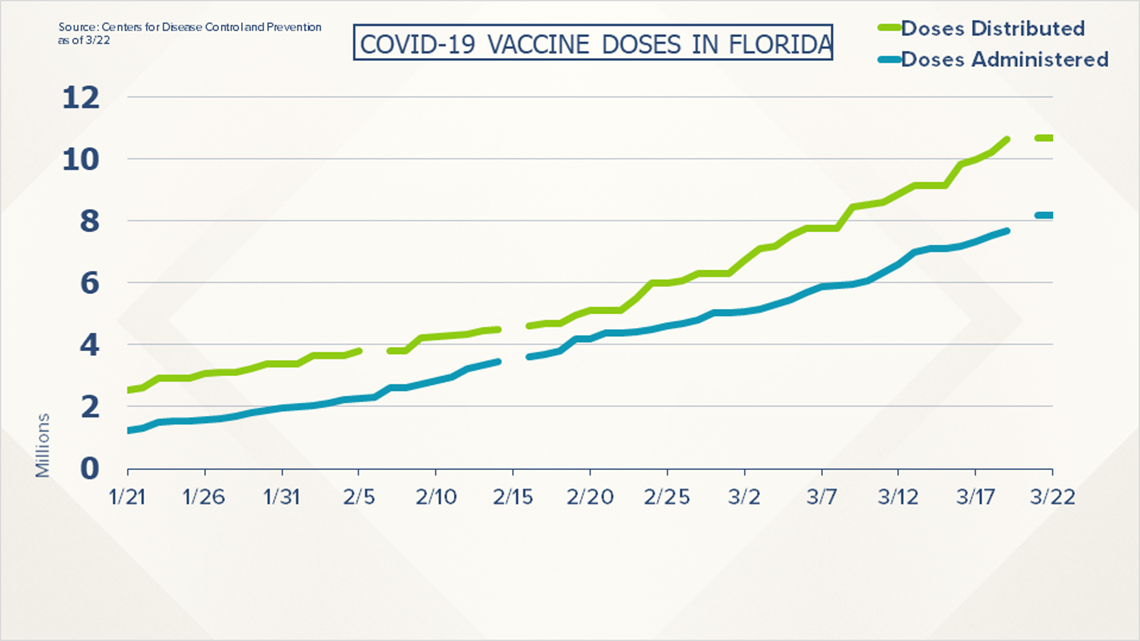
With more doses coming into the state and eligibility requirements expanding, these pharmacists hope the supply begins making its way to them, too.
"Unfortunately, we don't have an exact date and we weren't made aware of any exact date as to when we'll get it. So, we keep getting updates like hey, you're expected to get it by end of March or early April, that kind of thing. But we haven't gotten anything yet or any information regarding it," Huynh said.
"We have a long list of customers calling on us every other day asking when we can get the vaccine and they can get it from us."
They are ready and so are their customers who have relied on them for all their other medical needs.
"Because we're like family with our customers. You step in and you know, we know your name and everything. So that is why they want us to be the one that administers the vaccine," Huynh said.
Walmart, CVS, Publix, Walgreens and Winn-Dixie are all offering vaccines in Florida.
In just the past week, those pharmacy chains have expanded vaccines to hundreds of their stores.
And, remember pharmacies aren't just following state guidelines, they're also following federal guidelines. So, any educator or childcare worker can get vaccinated.
See the full list of where you can get vaccinated here.
DAY 50 UPDATE:
We are halfway through President Biden's goal of 100 million vaccines in 100 days. Just last night, the president said he will meet his pre-set goal in the next 10 days.
Here is what the numbers look like nationwide today:
(Remember these are the numbers since President Biden took office, not total numbers.)
Day 10: 13.6 million Americans vaccinated.
Day 20: 27.2 million Americans vaccinated.
Day 30: 43.7 million Americans vaccinated.
Day 40: 61.1 million Americans vaccinated.
Day 50: 83.6 million Americans vaccinated
The COVID-19 vaccine rollout in the United States is basically 50 different plans happening all at once.
For a look at how it’s going across the country, 10 Investigates' Jennifer Titus joined reporters from our sister stations in California, Colorado, Texas, Oregon and Ohio to talk over Zoom about what’s working and what's not in their respective states.
The group also went over the complaints coming into their newsrooms.
Mike Duffy: ABC 10, Sacramento, Calif.
You've got to keep in mind that California is a state of 40 million people. So it's a huge undertaking, no matter what happens. And the fact of the matter is, we are getting shots in people's arms, albeit at a very middle-of-the-road pace. I would say right now we have gotten about 15 percent of people at least one dose and 5 percent have gotten two doses.
The government sent us 11.5 million doses, and we have used about 8.5 million of those. So, that sounds pretty good. But we are 29th out of 59 states and municipalities, and that just puts us at about a C average. So, it's good, but it's average.
Jennifer Titus: WTSP, Tampa, Fla.
So, in Florida, we actually started out with a seniors-first approach, and at first, it was a mess like everywhere else. The infrastructure wasn't there, the website was crashing, the phone lines were going unanswered.
After a couple of weeks, basically, the state rolled out a statewide registration system for most of the counties. And some of the counties outsourced with a contractor to run the appointments and the bookings.
Right now, more than 50 percent of our senior population has been vaccinated and they just started opening up new groups this week. We're seeing some law enforcement, school teachers, firefighters 50 and over being vaccinated. And especially with this Johnson & Johnson approval, we're getting a lot of vaccines into the state. People will call me saying, 'Oh, we're having such a hard time finding an appointment,' and a day or two later, I get a phone call that said they were able to book. It does seem to be getting better as more of these vaccines are coming in.
Chris Vanderveen: KUSA, Denver, Colo.
Colorado right now is good, not great. I think the best thing that can be said about Colorado is that we are really, really close to getting 70 percent of our 70-year-olds and older vaccinated. Right now, that's a big deal in a state like Colorado. It's a big deal around the country to get that most vulnerable group vaccinated.
It's a wickedly complex number, but it's really the metric that the state is sort of going on. And today we learned that long-term care facilities, the number of cases in those facilities—probably not surprising because we'd gotten a lot of vaccine in the arms of these folks—those case numbers are going way down just within the last two weeks. We're seeing really tangible evidence that the vaccine is working and it's preventing cases. It's preventing hospitalizations in the most vulnerable population.
Brad Streicher: KVUE, Austin, Texas
Texas, like California, also has a massive population on its hands, obviously. So, trying to get the vaccine into people's arms is going to be a huge undertaking, regardless. The one thing that I think our state is doing fairly well— I've seen reports in several different cities and other states across the country that are having some issues with a lot of doses that are being wasted, either improper storage or other issues— I think that we see a relatively lower number, especially in our local area of Austin. We're seeing very few of those doses being wasted.
Rachel Polansky: WKYC, Cleveland, Ohio
I think the governor had a good idea in that we targeted the most vulnerable first, being the front-line workers and the elderly in long-term care facilities. I think that hurt us as well because, you know, it's easier to stick a needle in anyone. Instead, we chose specific groups and it slowed us down.
Cristin Severance: KGW, Portland, Ore.
The state has done a really good job when it comes to COVID deaths in general. We've had the strictest lockdowns, but we've also had a really low number of deaths. I think only Alaska, Maine, and Hawaii have lower numbers in terms of people dying from COVID. And then when it comes to the vaccine rollout, we've also done a decent job of getting shots in arms. I just checked the numbers and we've used 82 percent of our supply.
Mike Duffy: ABC 10, Sacramento, Calif.
When it comes to mass vaccination sites, the idea is wonderful. The reality is impractical, especially here in California, where it's a really decentralized approach. So, the state gives the vaccine to each of the counties and then they get to choose how they distribute it and kind of under what guidelines. Even if the state says teachers can get the vaccine, it's ultimately up to the counties. And now, if you want to get the vaccine at one of these massive vaccination sites, you have to either live or work in that county, which kind of defeats the purpose of this mass vaccination site.
So, we get a lot of confusion here in California, where people are asking, 'Hey, can I go to "blank" stadium and get my vaccine?' And the answer is almost always "no" unless you live or work in that county.
And the fact of the matter is, California is the fifth-largest economy in the world. Our GDP is bigger than Russia. And the fact that we are just a C grade at this point in time is a bit of a shame. I mean, it's rather embarrassing at this point and we really got to figure it out. Plus, we are the center of the tech world and we still haven't found a way to streamline this whole process.
Brad Streicher: KVUE, Austin, Texas
The lack of streamlining the process is an issue that we've seen here in Texas. I think one of the things that we're doing the worst with vaccine rollout is simply the organization of figuring out not only how to communicate this to people. But, for example, we reported very early on that even though there are lists of requirements for certain individuals who qualify in these different groups who can get the vaccine, the state is not requiring providers to confirm any details about anybody who's getting that vaccine.
And so we've reported on cases where people who do not meet those standards are going in and getting this vaccine ahead of the time when they shouldn't be getting it, which is them taking it away, obviously, from somebody else who falls into that high-risk category and could use the shot.
Chris Vanderveen: KUSA, Denver, Colo.
Here in Colorado we, like many states, elected to not really have a centralized location for the distribution of vaccines. And that's led to a lot of confusion over the last few weeks as people sort of scrambled to figure out where to get the vaccine from. There are a lot of providers in the state of Colorado. There are a lot of providers just in the Denver metro area. And because of that, people are signing up on multiple lists to get vaccines from multiple providers, and then they'll get their vaccine from one provider. And there's really no great way to tell the other provider that they already got the vaccine. So, it's led to a lot of confusion along the way with people just trying to figure out where and when they're eligible.
Combine that with the fact that the governor has sort of changed the rules a couple of times. Restaurant workers thought they would be getting vaccinated this week. That's now not going to happen; grocery store workers are getting vaccinated starting at the end of the week here in Colorado. But a lot of people wondering when is their spot going to be, when is their time going to be coming up? We've been fairly efficient in getting the vaccine out, but the problem so far has been the communication. It has not been good. They're getting better, but it certainly has been a problem.
Jennifer Titus: WTSP, Tampa, Fla.
I think we are the one state that doesn't have a plan. I think if you guys look at all of your departments of health, you'll see a plan where it says this group is up, now this group's next and this group is after that.
Well, Florida doesn’t have that. The governor is kind of just taking it day by day. He basically has been on this senior-first approach. Now we've gotten a lot of our seniors vaccinated, he's like, 'All right, I'm going to lower the age probably next week, maybe to 60 and over or 55 and over.' So, really, the thing is: Who's next? Who's going to be able to get those vaccines next? And there's a lot of push, of course, for teachers and other people that find themselves on the front lines waiting to get vaccinated.
Rachel Polansky: WKYC, Cleveland, Ohio
Our governor has taken the approach of vaccinating non-nursing home elderly through our local pharmacies, instead of, say, a mass vaccination site. He has said that he's done that because he thinks it'll make the elderly more comfortable to go to a pharmacy instead of a place they haven't been before.
But some critics say that is also hurting our numbers and contributing to our low ranking. I will say it's tough, though. States in warmer climates can do these mass vaccination sites. In Ohio, we can't have an outdoor vaccination site in January and February, especially for older people. So, I think that has hurt us.
Cristin Severance: KGW, Portland, Ore.
I would say in Oregon, what's not working is there's just a ton of frustration and confusion on how to sign up for the vaccine. So, there are five or six different sites just in the Portland metro area where you can go to sign up. And none of the sites can really handle a lot of people. So, just the technology part of it, you would think, would be a little bit better. And then in Oregon, we're one of two states that did prioritize teachers ahead of seniors, and so 65 and up just started March 1.
Rachel Polansky: WKYC, Cleveland, Ohio
I think, like everyone has been saying, Ohio is middle of the road. We are ranked 29th. Could we do better? Definitely. Could we do worse? Sure. The big complaint that we've gotten is about delays. And the delays in shipment can be contributed to several things.
As I mentioned before, being in Ohio, the winter storms didn't help. I also think our early eligibility lists were too stringent. We didn't get a centralized website up and running until a week or two weeks ago.
Mike Duffy: ABC 10, Sacramento, Calif.
I would really say that decentralization has been our biggest problem to this point. And really, because the state thought that would be the best way to address individual communities, what we're learning is that in a vaccination campaign like this, it just doesn't work well fast enough. And this has led to confusion.
The state will say teachers are allowed to be vaccinated, but when the teacher tries to sign up in their particular county, that county will stop them and say: "Actually not right now, we're still vaccinating our seniors" or "We're still vaccinating those people in group-care facilities." So, that has been a continued problem.
And I'd also like to highlight one thing that's really particular to California here, which is farmworkers. Farmworkers are all over the country, but here in California, we grow two-thirds of all the country's fruits and vegetables. And it really matters what these farmworkers are doing. And if they're staying healthy.
In these communities, many of them tend to be undocumented. And many of them have a distrust of the health care system in general, plus they're transient. And in order to keep them safe, you actually need to bring the vaccine to them. It's unlikely that they're going to show up to a clinic, but if you make that available to them, then there will be great uptake. And so the counties, the state, have had to rethink all of these different methods that it thought it was going to use. And it's been slow to do that.
Brad Streicher: KVUE, Austin, Texas
In Texas, some of the biggest complaints have been the lack of organization of the rollout process from the state and the local governments. Communication for people is far and beyond one of the biggest complaints that we're hearing about. We are seeing a lot of people who will get the first dose, and then they don't hear anything about getting the second dose, or they're not being followed up with as quickly as they thought.
Jennifer Titus: WTSP, Tampa, Fla.
I think in Florida, and probably all across the country really, it's been that the demand just outweighs the supply. So, people qualify to get this vaccine, they think they're going to get it, and then they go to book an appointment and those appointments just aren't there. And of course, we're covering the story where these sites can do up to 2,000 vaccines a day. But when you talk to them and ask them, "Well, are you doing that? Do you have the vaccine, the supply to do that?" They're like, "Well, no, we don't." So, that's the issue that we're dealing with, that we still don't have the supply, that demand is still outweighing the supply.
Cristin Severance: KGW, Portland Ore.
So, you know, the governor prioritized teachers ahead of seniors. Some other states said, "Yes, we want teachers to get the vaccine," but Oregon really said, "Teachers are going to come first, even though seniors are dying the most from COVID." Gov. Brown put teachers first, that has been the biggest complaint, by far. It's unfair because it pits the seniors against teachers, but that's just the way it is. I mean, that's who she decided to vaccinate. That's really been the center of a lot of complaints.
Also, you talk about equity, Oregon talks a lot about equity. They created this 27-member panel. Their entire goal was to figure out how to roll this out in a fair way and how to make sure these underrepresented communities would get the vaccine. With 27 people meeting once a week to decide this, as you can imagine, it didn't really work. It was a lot of talk, they had some good ideas, but they really had no power. So, that's very on par with Oregon, where we talk a lot about these things, but really at the end of the day, there's no direct action to make sure that the vaccine is in fact equitable.
Chris Vanderveen: KUSA, Denver, Colorado
I think here in Colorado, there's lots and lots of demand and not nearly enough supply. And that hasn't changed for a number of weeks. A lot of people want to get the vaccine, which is a good thing at the end of the day. The supply just simply hasn't gotten up to where the public wants it to be.
Another issue that certainly is being raised here in Colorado is just the disproportionate angle. When it comes to vaccine distribution, I'm just looking at Denver numbers right now, people who identify as Hispanic or Latino made up close to 50 percent of all cases in the city and county of Denver. Roughly one out of every two cases in the city and county of Denver was Hispanic or Latino, yet they've only made up 9.1 percent of the vaccine distribution.
That's a problem for the city. That's a problem for the state. It is not going out equitably. And that is something that city leaders and state leaders are trying to address right now. They know they have a problem on their hands, but they simply have not been able to roll this out in a fair and equitable way, across the board. And that's something that people are noticing here in Colorado.
Mike Duffy: ABC 10, Sacramento, California
I just want to say this: Why now? Why are we just thinking about these problems, now? We knew that these vaccines were being developed a year ago. Why weren't we running war games like the Pentagon would about what could possibly happen? None of these seemed outlandish. None of these seem far-fetched. We knew all of these could be problems. So, I keep asking people to answer this question and frankly, I don't get a good answer. The best I ever hear is that "well, the previous administration didn't have a clear direction and so, we didn't know what to do." But to me, that's just lacking imagination.
Chris Vanderveen: KUSA, Denver, Colorado
Let's be honest here. We've had a 50-state solution from the beginning of this epidemic. States have been on their own, trying to figure out the best way to sort of combat this epidemic. And quite frankly, that means there are 50 plans around the country. There are 50 ways of moving forward and it's messy and it's not particularly helpful when you're in a state like Colorado or Texas or Florida or Oregon.
The bottom line is you just want to get some information and you just want to get some help as to figure out how to get the vaccine. And when it's not available, it's frustrating. That's the problem, and that's the situation that we have. We have 50 states scrambling to figure this out in one year in and it's been messy. It was messy a year ago. It's still messy today.
DAY 40 UPDATE:
President Joe Biden announced goals to get Americans vaccinated sooner than initially thought and to prioritize educators for some of those vaccines. That comes as we hit day 40 since he signed an executive order of 100 million vaccines in 100 days.

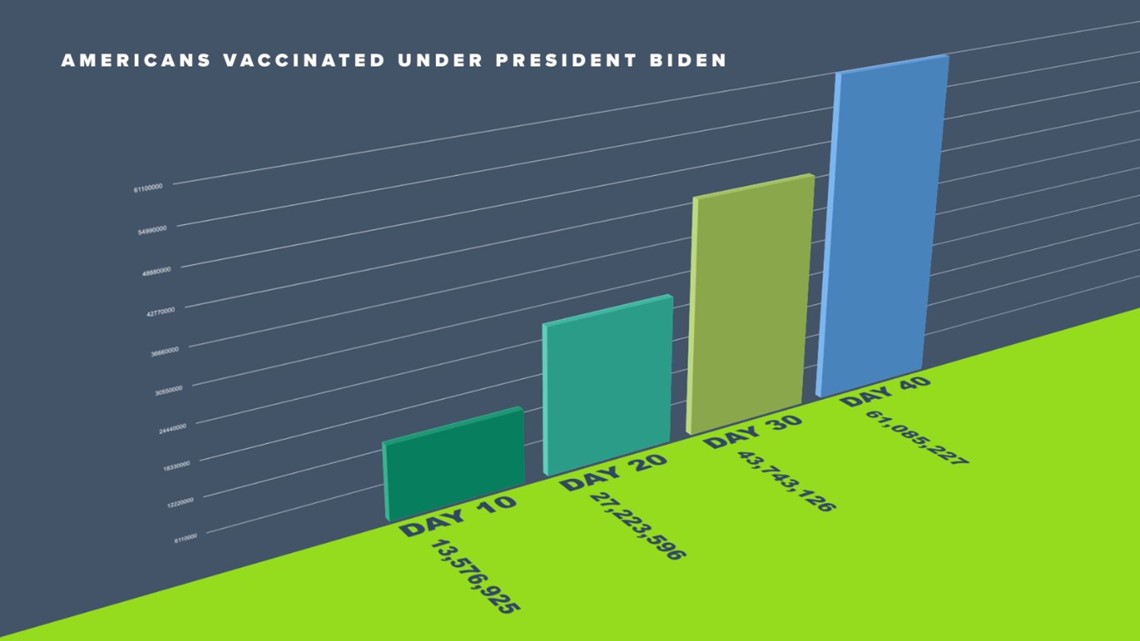
Since that executive order, the number of people vaccinated nationwide has steadily climbed.
On day 10, we were at 13.6 million Americans vaccinated. On day 20, 27.2 million. On day 30, 43.7 million Americans had been vaccinated and as of this week, on day 40, 61.1 million Americans have been vaccinated.
Remember this is the number of people vaccinated since Biden signed the Executive Order, not the total number.
You can see all those numbers here: https://covid.cdc.gov/covid-data-tracker/#vaccinations
But some high-risk Floridians under the age of 65 who have been eligible to receive a vaccine from the start, still struggle to find an appointment.
“I spend about an hour every day looking at every single hospital site that I'm aware of is getting an allocation of vaccine within a 50-mile radius,” Christy Hughes said.
But the vaccines just aren’t there for 62-year-old Hughes and the thousands of others under 65 who are high risk. They have qualified for a shot since December.
“It means everything. I don't want to get emotional, but I lost my father last August to COVID. And, I wasn't able to see him when he passed,” John Honoski was nearly in tears when he explained his COVID situation.
Honoski says because the order only allowed hospitals to give the shot to the high-risk group, it has been nearly impossible to book.
Many hospitals tell us they either don’t have any supply or that it’s reserved strictly for their patients
“That whole group should be treated the same,” Honoski said.
Now they will be. We told you earlier this week about a revision the governor made that now allows those with co-morbidities to be vaccinated by pharmacists and physicians even if they are under 65.
According to the latest data from the state, 5.1 million people in Florida have been vaccinated. Of that number, nearly 452,000 are under 65.
Those numbers will continue to grow as the state opens its first four federal sites Wednesday and now begins allowing law enforcement, firefighters and educators over the age of 50 to get a vaccine.
And, just yesterday, the president announced his goal to get all pre-K through 12th-grade staff members and childcare workers in the country one shot by the end of March.
10 Investigates reached out to DeSantis' office and the Office of Emergency Management in Florida to see if there are plans to change the age of eligibility for educators in the state. We have not gotten any response.
Honoski says the new order will make it easier for people like him to make an appointment for a vaccination.

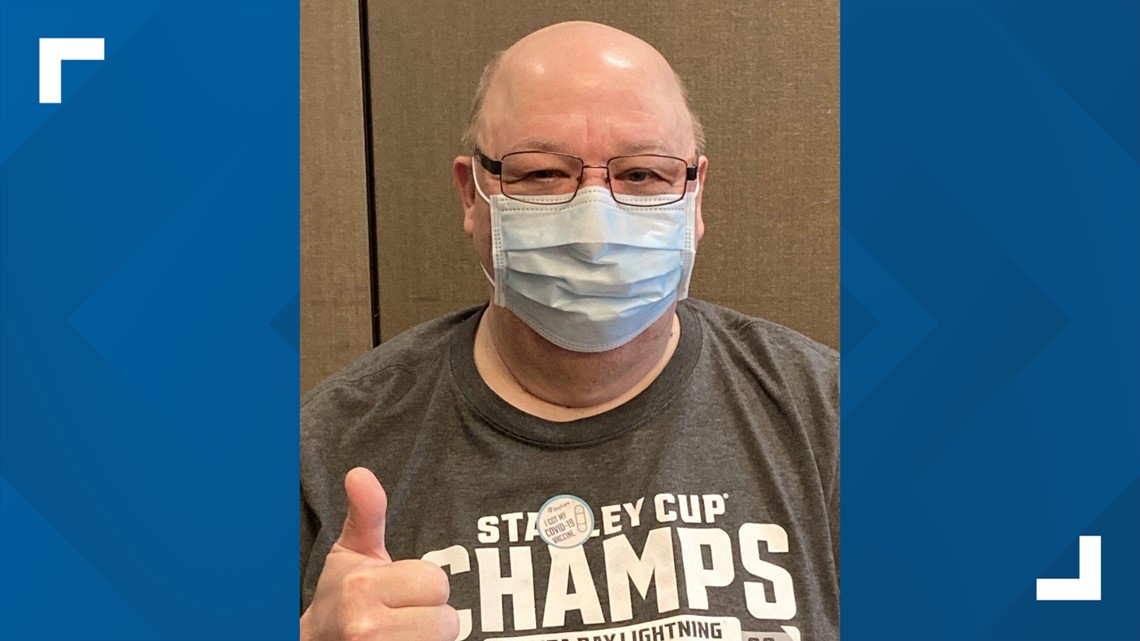
He finally got his shot.
"My daughter is graduating from FSU. And we just got a notice yesterday that the graduation will be on April 18, which is my dad's birthday. It would be his 90th birthday. And we can attend in person,” Honoski said.
Hughes finally got her shot, too.
“I want to shop for my own groceries again. I am so tired of someone else picking out my meat and vegetables,” she said.
With the Johnson and Johnson vaccine now approved, Florida is set to get 175,000 of those doses by the end of the week. The governor also mentioned with the amount of vaccine coming into the state continuing to increase he will be lowering the eligibility age for those who can get vaccinated.
The Florida Department of Health this week released a form for physicians in the state to use for patients who are extremely vulnerable. It will start being used Wednesday.

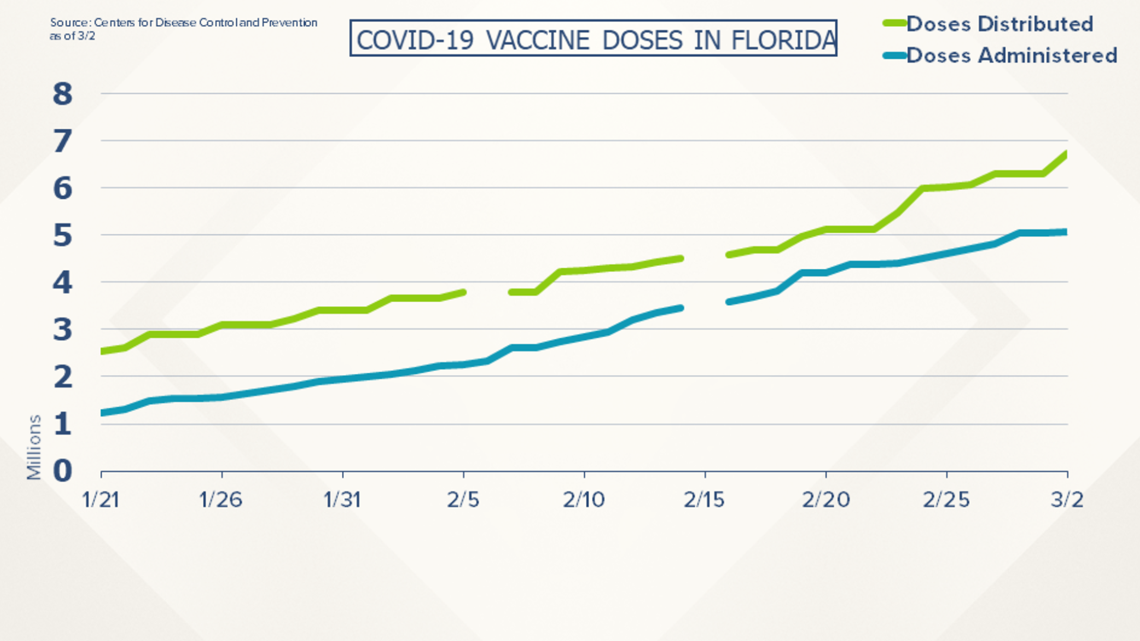
With the number of doses coming into the state, we're also seeing more pop-up sites and pharmacies offering vaccinations.
Two pop up sites in Polk and Pasco counties will give 3,300 Pfizer vaccines each in the next three days to people 65 and up.
The governor also announced that two more Walgreens will begin offering vaccines on Friday. Those locations are in Hudson and Zephyrhills and will be added to the list of pharmacies on the Walgreens website.
You can schedule vaccines here:
- Winn-Dixie: https://www.winndixie.com/pharmacy/covid-vaccine
- Publix: https://www.publix.com/covid-vaccine
- Wal-Mart: https://www.walmart.com/cp/1228302
DAY 30 UPDATE:
President Joe Biden is ambitious about getting Americans vaccinated. Over the weekend, the president visited a Pfizer facility and said he believes we will surpass his 100-million doses in 100 days goal.
The news comes as we hit day 30 of that promise. Nationwide on day 10, we were at 13.6 million vaccinated under the Biden administration. That number more than doubled at day 20 and then on day 30, we are at 43.7 million shots in arms. Remember these are the doses administered since Biden's promise. They do not count the total number of vaccines administered before he took office.
We are 44 percent of the way to the 100-million goal.


"Not very satisfying:" Those are the words of 69-year-old Carlo Brauer when he described the process of getting vaccinated. Like most of the 4.2 million seniors in the state of Florida, Carlo had some trouble booking his COVID vaccination appointment.
“I tried to log in. After two hours, a message came out saying all appointments have been scheduled,” Carlo explained.
After trying over and over for an appointment, he was finally booked for a dose.
"We're getting more doses and vaccinating more people,” said Maggie Hall with Pinellas County Department of Health.
Hall says the additional doses have allowed them to add more vaccination sites across the county.
"This new Largo site has a capacity to go up to 2,000 vaccines a day,” Hall said.
And it’s not just Pinellas County seeing more sites open. The state has added pop up sites across the state, focusing on communities where the percentage of seniors vaccinated is low.
“Statewide we are at 42 percent, and in Pinellas County, just 35 percent. So that's why we’re allocating more here,” DeSantis said in a news conference.
In Florida, nearly 3,000,000 residents have been vaccinated. That is 14 percent of the population. But even so, we have many more residents waiting on a vaccine, but officials continue to say the supply isn’t there.
Remember, that Largo site could vaccinate up to 2,000 people a day.
“At this point, we're using the vaccines that we have or making appointments, again for what's on hand. So, it has the capability of going up to that,” Hall said. The site is not yet vaccinating 2,000 people a day.
Some of Florida’s supply was delayed because of winter storms, pushing back some appointments for those already scheduled.
"I am from the era of the polio vaccine, and that worked. That truly was a blessing. So, I'm kind of of the mindset that vaccinations do more good than harm,” Carlo said.
Carlo says he hopes the supply keeps coming in so everyone can be excited to go on with life like he is.
The chief executive at the Pfizer manufacturing plant Biden visited promised 200,000,000 million vaccines by May, 2 months ahead of schedule.
Biden also says he believes there will be enough vaccine for all Americans by the end of July and he hopes the nation will be “approaching normalcy by the end of this year.”
DAY 20 UPDATE:
Tuesday marked 20 days into President Biden's promise of 100 million vaccines in 100 days.
Overall, 43,206,190 vaccinations have been administered nationwide.
Since President Biden's executive order went into place 25,659,816 doses have been given. If we stay at this rate, the president will make good on the goal of 100-million vaccines in 100 days.
Here in Florida, state leaders have criticized the supply coming in from the federal government saying it's not enough.
10 Investigates Jennifer Titus went to the state capital for a behind the scenes look at vaccine distribution from the Florida Division of Emergency Management.
When the State's Emergency Operation Center is activated at level one that usually means a hurricane is brewing close by but for the last year, the focus has been on the pandemic and vaccine distribution.
"We've been here for 330 plus days at a level one," Jared Moskowitz, the Director of Emergency Management shared.

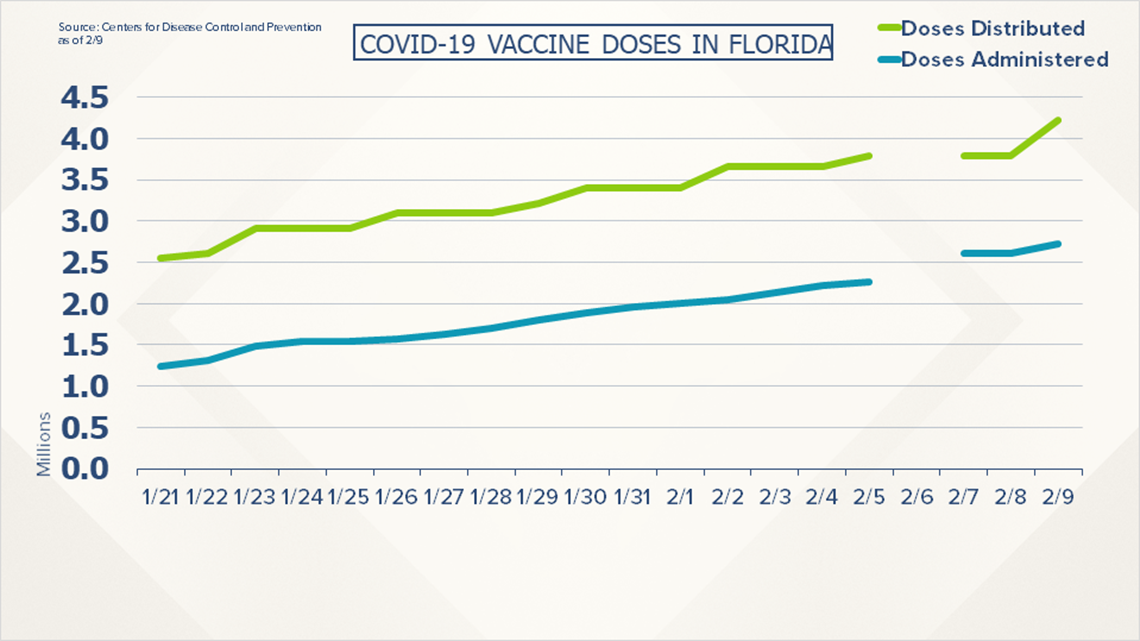
Two hundred and fifty people work at the EOC and use data to make distribution decisions.
"So, you know, where we have the 65 and older population in each county, we take the doses we have. And it's just simple math. And that's how it gets allocated," Moskowitz explained.
Titus asked Moskowitz about the difference in doses allocated using Pasco County's vaccines as an example. Turns out distribution is also reliant on sites opening and shared the greater Tampa Bay area county is slated to see 9,000 doses a week.
"No. So, that was early on before sites were open. Now once sites get open, it's all equal," Moskowitz said. "At first, it was short, because they didn't have the ability to get the doses out. So, we didn't want to bury doses in freezers."
Moskowitz says he wishes more vaccines could go to each county, but he says, the state is not getting the supply needed from the federal government. He even gave the federal government a low grade when it comes to distribution efforts.
"You know, on distribution, they get a huge 'F'. There's just no better way to say it," he added.
Bottom line, Moskowitz says, there was no distribution plan.
"None whatsoever. We have 4.3 million seniors in the state of Florida. We told them that the vaccine would be available to them and it's not. And so that's because the federal government did not give us the information to tell us what the production schedule was going to be," the Director of Emergency Management said.
He also discussed the state's distribution being criticized by some county health departments.
"So, look, there was a plan, there was a distribution plan, but the plan is impacted by supply. Supply caused all of those problems," Moskowitz said. "I'm frustrated, I'm frustrated that we can't meet the demand. I'm frustrated that I can't help get to the end of this nightmare sooner. But I'm not in control of the supply."
Since vaccine rollout began in Florida, 1,965,590 people have been inoculated. The state has also seen 1.5 million vaccines since President Biden promised 100-million vaccines in 100 days.
At 20 days in President Biden has met 25 percent of his goal as of the more than 43,000 overall vaccinations, 24,871,243 of them occurred under his administration
"We are at the will of these companies that produce the vaccine, and we're just not getting enough of it. And again, I know the administration is doing everything they can to fix those issues. But poor planning from the federal government for the last six months is what we are all now feeling," Moskowitz said
DAY 10 UPDATE:
One-hundred million vaccines in 100 days. That's the promise President Joe Biden made when it comes to vaccinating Americans against COVID-19.
And after some pressure, Biden raised that number to 150 million. Biden then dropped the number back to 100 million doses. Sunday, Jan. 31, marked Day 10 of the promise.
Every tenth day of the 100-day promise, 10 Investigates will be updating the numbers. Where do we stand as a country and as a state?
When it comes to the country, we have vaccinated 31,123,299 people. Now, that is overall, since the first vaccine was given back in December.
Since Biden's executive order, we have vaccinated 13,576,925 people. That is 14 percent of 150 million. So, where do we stand so far? If we continue to vaccinate that exact amount of people for the next 100 days, that will bring the total to 135,769,250, which would be short of the 150-million goal.
Where are we for the state of Florida? As of Monday, the Centers for Disease Control and Prevention is reporting more than 2 million people have been vaccinated in the state. Some say that's not enough.

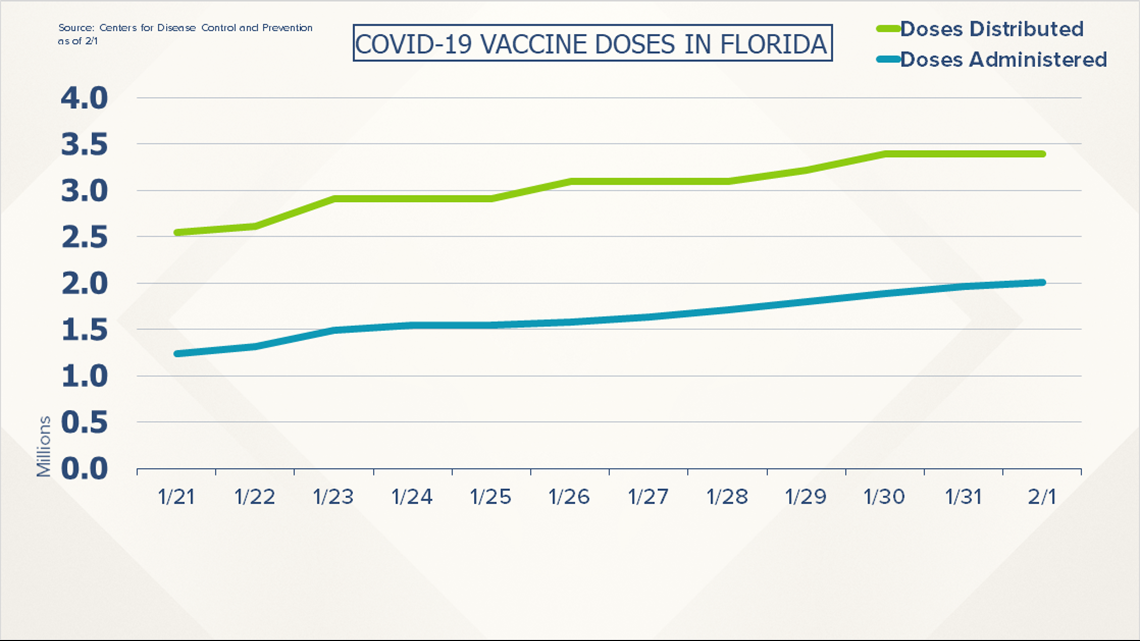
Larry Hollis, a 67-year-old veteran, is one of the 4.2 million seniors in the state of Florida who are eligible to get a vaccine. Hollis reached out to 10 Investigates after he had issues signing up for a vaccine.
"I tried to sign up. And I've tried, I think four times, to no avail," Hollis said.
But as of Monday, only 1,202,026 people have received a vaccine. That's less than a quarter of the senior population.
Gov. Ron DeSantis blames that on the federal government, saying the state is not getting enough vaccinations.
"Call your congressman, your U.S. Senators and tell them we need more vaccines," said DeSantis in a news conference.
So, 10 Investigates did just that. We emailed and called both Sens. Marco Rubio and Rick Scott's offices, asking for just 5 minutes for an interview over a week's time.
Rubio's office told us they wouldn't be able to make anything work. Scott agreed to speak with us.
"It's important that we get vaccines out to the states as we can add responsibility to states to get this out to individuals as quickly as they can," Scott said. "And of course, get the most to the most vulnerable. First, to get that as quickly as you can. So, we're working with the HHS, we're working with the manufacturers, I've talked to them about the importance of getting this out because we can, and we're going to do everything we can up here."
The states receiving the most doses so far are California, Texas, Florida and New York state.
Vaccines aren't just going to the states. More than 3.1 million doses are going to eight territories including Guam, the Republic of Palau and the Federated States of Micronesia and to federal entities, including the Bureau of Prisons, Department of Defense, Indian Health Services and Veterans Services.
"What we're hearing is people want more information. They want an easier access. It always comes down to people want more information," Scott said.
It hasn't been easy getting information from the Biden administration about vaccine distribution, Scott claims.
"If you're going to be in the executive branch, you really have to create a process for transparency, for it to happen. It's not just having a nice speech about it. It's really you got to create a process of transparency," Scott said. "Right now, we have funded more money, way more money that's been spent on distribution."
For Hollis, like the 3 million other seniors still waiting for a shot, he hopes the supply will increase soon and he'll be moved to the column on the list showing he received his first dose.
"Because until we're vaccinated, we're just gonna be in this holding pattern. And I like everybody else. I'm tired of this. Let's move on," Hollis said.
And this week, Florida will see an increase in weekly doses from the federal government. In the past, we were receiving about 250,000 doses. This week we'll get 306,000 doses.
To put that into perspective, though, that number doesn't even equal the number of seniors in all of Pinellas County, which has more than 420,000 seniors.
The governor would like to see 5,000 doses a week. Of course, we'll be keeping track. You can keep track of the CDC data here: https://covid.cdc.gov/covid-data-tracker/#vaccinations
- It's Florida's Severe Weather Awareness Week
- BBB: Stop posting pictures of your COVID-19 vaccine card on social media
- Remembering the NASA Columbia crew 18 years later
- Didn't get a ticket to the Super Bowl Experience? No problem! Here are other ways to enjoy the big game
- Here's what to expect at the Super Bowl Experience in downtown Tampa
- Everything you need to know about Super Bowl LV in Tampa
►Breaking news and weather alerts: Get the free 10 Tampa Bay app
►Stay In the Know! Sign up now for the Brightside Blend Newsletter

